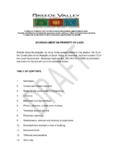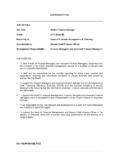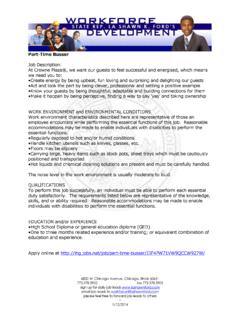Transcription of COSTING POLICY - bvm.gov.za
1 COSTING POLICY . 1. Compiled by: Unathi Poyo TABLE OF CONTENTS. Description Page No. 1 Definitions and Abbreviations 3. 2 Introduction and Background 5. 3 Purpose of COSTING POLICY 6. 4 Objective of Cost accounting 7. 5 Benefits of a COSTING System 7. 6 COSTING Concepts / Methods 8. 7 Cost accounting , Unit Costs and Types of Costs 11. 8 Activity-Based COSTING (ABC) 12. 9 Steps in implementing ABC 14. 10 Support Services and allocation thereof 15. 2. Compiled by: Unathi Poyo 1. DEFINITIONS AND ABBREVIATIONS. a. Cost accounting : As the major pillar and prerequisite for all application of good management accounting in municipalities, cost accounting can be the process of determining the cost of providing services, broken down into cost elements to enable the effective allocation in the determination of rates and tariffs b.
2 Management accounting : Management accounting is accounting which is based on cost accounting principles and endeavours to provide information for internal decision making by management. c. Financial accounting : Financial accounting deals with the reporting information pertaining to the financial position, and performance of a municipality for a given period to particular users and the community (public in general). d. Financial management: Financial management refers to the efficient and effective management of money (funds) in such a manner as to accomplish the objectives of the organization. e. Cost Centre: a unit, such as a department of a municipality, to which costs may be allocated for cost accounting purposes f.
3 Annual budgets: Any budget that is prepared for a 12-month period. An annual budget outlines both the income and expenditures that are expected to be received and paid over the coming year. Annual budgets are used by individuals, corporations, governments and various other types of organizations. g. Basic municipal service : A a municipal service that is necessary to ensure an acceptable and reasonable quality of life and which, if not provided, would endanger public health of safety or the environment. h. Financial year means a year ending on 30 June i. Local municipality has the meaning assigned to it in section 1 of the Municipal Systems Act.
4 J. Month means one of the 12 months of a calender k. Municipal council' or council' means the council of a municipal referred to in section 18 of the Municpal Structures Act l. Municipal Manager means a person appointed in terms of section 82 (1) (a) or (b) of the Municipal Structures Act m. Standard cost: the predetermined budgeted cost of a regular manufacturing process against which actual costs are compared n. Variable costs: These are costs that vary with consumption or volume produced. 3. Compiled by: Unathi Poyo o. Total cost: Is the sum of all fixed and variable costs. p. Direct Costs. These costs can be traced directly to one output, for example the material costs (syringe, docage) to immunise one patient.
5 Q. Indirect Costs. These are costs that cannot be allocated to an individual output, in other words, costs that benefit two or more outputs, but not all outputs, for example maintenance costs for equipment, storage costs, other materials, and quality assurance. r. General and administrative costs. These are costs that cannot reasonably be associated with any particular product or service produced or service produced, commonly referred to an overhead costs. These costs would remain the same no matter what output the activity produced. Examples are salaries of personnel in the purchasing department, depreciation on equipment, and security ABBREVIATIONS: 1 ABC Activity-based COSTING 2 MSA Municipal Systems Act 3 MFMA Municipal Finance Management Act 4.
6 Compiled by: Unathi Poyo 2. INTRODUCTION AND BACKGROUND. Cost accounting (also called management accounting ) differs from financial accounting and financial management in that its main focus is on the internal processes of an organisation, and the management thereof. Financial accounting and financial management is mainly focussed on the external reporting of an organisation's position and performance as well as the analysis of such reports. Another attribute of cost accounting is that it is up to each organisation to establish its own methods to do cost accounting . The MFMA. may, for example, compel a municipality to go through a budgeting process yearly.
7 The format and content of the annual budgets are regulated by MFMA Circular 28, but since many principles (such as Zero-Based budgeting) necessitates a COSTING process, the extent and nature of the COSTING process is not prescribed. The concept of delivering value for money (VFM) has been introduced in management (or cost) accounting and this can clarify the objective of cost accounting . The three components of VFM relate to the achievement of: Economy Using the best quality resources at the lowest possible cost (cost vs. benefit). Effectiveness Achieve the desired end result from any given activity (doing the right things). Efficiency Using resources in such a way that the maximum possible output is gained (doing things right).
8 Understanding the cost of what an organisation does, helps to price the products and services the organisation delivers. For example, if a municipality delivers a refuse collection service, it needs to understand how much it costs to provide the service. That will help them to make an informed decision about what to charge for the service. This also allows the municipality to plan and budget for expenditure and revenue for a planned or budgeted level of refuse collection service the cost of providing that level of services needs to be known. Each municipality must determine firstly what the desired results are that they need to achieve and then decide how to obtain those results while ensuring value for money.
9 Cost accounting gives an organisation a variety of choices in COSTING its products and/or services. Without calculating the costs of services, one cannot price services and therefore provide an affordable service to the consumers at cost effective levels. 5. Compiled by: Unathi Poyo Apart from pure cost collection, cost accounting can also assist with various decisions that have to be made in a municipality. For example, the cost that will be incurred to increase service levels can be determined or the cost that can be saved by providing services that are not cost effective to the municipality. Cost accounting can also identify how services can be better delivered.
10 Also, another important point is that the cost and pricing of a municipal service provides transparent information about which services are running at a surplus and which services are running at a deficit. This provides insight into POLICY decisions on cross subsidisation of services. For example, information on COSTING and pricing may reveal that a municipality is not recovering costs in relation to its refuse collection service and that the shortfall is being funded from other sources. Understanding costs also assists in making decision regarding provision of basic services and subsidisation of some service receivers by others through the pricing structure for that service.














